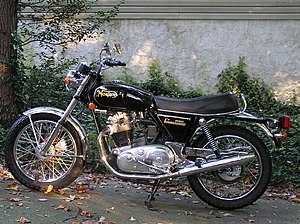Norton Isolastic frame


The isolastic frame, designated by Norton as GlideRide,[2] used a system of engine-to-frame mountings incorporating rubber bushes to isolate the vibration of the vertical twin engine from the frame and rider. The isolastic frame was developed for use with the Commando inclined engine, whilst the Featherbed frame continued in production for the Mercury with a softer-specification 650 cc vertical-engine until 1970.[3][4][5]
History
[edit]Following the collapse of the old Norton parent-company AMC in 1966, a new business was structured to produce motorcycles using the name Norton Matchless Division, under a new parent company name of Norton Villiers Ltd.[2]
Part of the changes involved creating a new design frame produced as previously by Reynolds Tubes in Tyseley, Birmingham, England, where the traditional Featherbed frame had been produced since the 1950s, shipped for assembly at the Matchless works in Woolwich, London.[6]
In an attempt to reduce the worsening problem of engine vibration being transmitted through the frame, as the capacity of the engine increased to 750cc with the Norton Atlas, Norton Villiers decided to replace the Featherbed frame for their top model, and the Norton Commando was the result, although Norton-Matchless machines like the P11 continued to use conventional Matchless frames.
The innovative new design isolastic frame made it smoother through the use of rubber bushes to isolate the engine and swingarm from the frame, forks, and rider. As the rubber bushes deteriorated, however, the bike became prone to fishtailing[clarification needed] in high-speed turns.[7] Earlier models therefore required careful maintenance and adjustment of the clearance between frame and mounts using shims.
Several improvements were made in 1969. The frame benefitted from additional stiffening and strengthening,[8] which, together with an improved centre-stand, helped to improve ground-clearance which had been criticised. Slightly softer rubber mountings were introduced to reduce a vibration period at 1,500 to 1,900 rpm. A new model named Commando S was introduced with alternative styling having a different tank, mudguards and high-level exhausts.[9][4]
The six-storey former Matchless factory at Woolwich closed on 25 July 1969, and production was transferred to a new, small, modern facility at Andover, Hampshire,[6] when the range was expanded to five Commando variants—Fastback, Roadster SS, Production racer and Hi-Rider, all having "Isolastic Construction—Norton's revolutionary answer to vibration".
By 1971, the company name had changed again to Norton Villiers Europe Ltd.[10] By 1973, a variant on the Roadster was introduced named Interstate, with larger 53⁄4-gallon (27 litre) fuel tank replacing the original US-specification 21⁄2 gallon (18 litre) capacity.[1] By 1974 the company name had changed yet again, to Norton Triumph Europe Limited.[11]
Prototype models
[edit]As part of an attempt to produce new models from existing parts, NVT produced a few prototype models using the Isolastic engine mounting system. None of the prototypes made it into production.
Norton P92
[edit]The P92 model comprised a BSA B50 engine in a BSA Fury/Triumph Bandit frame using Isolastic mountings from the Norton Commando. The US DOT had mandated that all motorcycles sold in the US should have a left hand gear change. The B50 had the gear lever on the right, so to comply with this requirement, the engine was tilted forward in the frame and a gear linkage run under the gearbox to provide a left hand gear change.[12]
900 Commando
[edit]A prototype '900 Commando' was also produced.[12][dead link] It used a Triumph T180 triple engine (a T160 Trident engine increased in capacity to 870 cc) in Commando cycle parts.[13]
References
[edit]- ^ a b Motorcycle Mechanics, June 1973, p.2 Full-page colour Norton factory advert. "Commando Roadster with 21⁄2 gallon (18 litre) steel petrol tank...also available Commando Interstate, with larger 53⁄4-gallon (27 litre) long distance steel petrol tank". Accessed 3 January 2016
- ^ a b Grand Prix, 1968 soft-back book, p.34, full-page B&W factory advert, a Motor Cycle News special publication. "Suddenly we've started a revolution on two wheels - It's called the COMMANDO 750. Inclined engine, better cooling. GlideRide frame—goodbye vibration" Accessed 1 January 2016
- ^ Motorcycle Mechanics, May 1969, p.63 SHOWTIME. Show scene '69."Last of the traditional Nortons is the 647 cc Mercury. This machine has the Commando type cylinder head and single carburettor, producing 47 bhp. A rev counter and stainless steel mudguards are available as extras". Accessed 3 January 2016
- ^ a b Motorcycle Sport, April 1969, p.126, p.133, p.135 Accessed 1 January 2016
- ^ Woollett 2004[verification needed]
- ^ a b Motorcycle Sport, July 1971, pp.273-274, "When motorcycles were made in London". Accessed 2 January 2016
- ^ Bacon 1989[verification needed]
- ^ Motorcycle Mechanics, May 1969, p.63 SHOWTIME. Show scene '69."The Norton Commando will appear with a slightly strengthened and consequently more rigid frame for 1969". Accessed 3 January 2016
- ^ Motorcycle Mechanics, May 1969, p.63 SHOWTIME. Show scene '69."Seen for the first time at the Brighton show will be the Commando 'S' restyled to a more sporting specification, resulting in improved performance". Accessed 3 January 2016
- ^ Motorcycle Sport, July 1971, p.257, "64 years ahead". (1907 first TT win to 1971) Full-page factory advert, Norton Villiers Europe Ltd, Andover, Hants. Accessed 2 January 2016
- ^ Motorcycle Mechanics, December 1974, p.2 Full-page colour Norton Triumph factory advert. "Buy British. You've arrived.". Accessed 3 January 2016
- ^ a b Tanshanomi, Peter (6 January 2015). "Two Wheel Tuesday: Last Gasp Norton Isolastics". Hooniverse. Archived from the original on 15 September 2018. Retrieved 14 September 2018.
- ^ Brooke, Lindsay (2002). Triumph : A Century of Passion and Power. MotorBooks International. p. 125. ISBN 9781610592277.
Further reading
[edit]- Bacon, Roy H. (1989). Norton Commando, All Models. Niton Publishing. ISBN 9780951420430.
- Clarke, R. M. (2001). Norton Commando: Ultimate Portfolio. Brooklands Books Limited. ISBN 9781855205703.
- Henshaw, Peter (2017). The Norton Commando Bible: All models 1968 to 1978. Veloce Publishing. ISBN 9781787110069.
- Vale, Matthew (2011). Norton Commando: The Complete Story. Crowood Press UK. ISBN 9781847972385.
- Woollett, Mick (2004). Norton: The Complete Illustrated History. MBI Publishing Company LLC. ISBN 9780760319840.
